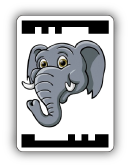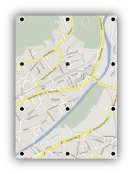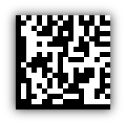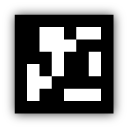Marker tracking has revolutionized Augmented Reality about a decade ago. However, this revolution came at the expense of visual clutter. We developed methods that allow tracking beyond the visibility of markers to improving robustness. These techniques are highly efficient in their memory and CPU usage and run at interactive frame rates on mobile phones.
The following techniques are already integrated into our
Studierstube Tracker software library.
 | Frame markers. Robustness of marker tracking is largely owed to the high contrast afforded by the black frame in a thresholded image. The frame itself is not disturbing in many situations, if the interior can be filled with application specific artwork, like a framed painting. With frame markers we therefore take the approach of encoding a digital id with error correction at the interior side of the frame, making it appear like a frame decoration. Frame markers have turned out to be highly attractive for branding, since companies can place a logo inside the marker. |
 | Split markers. While frame markers still contain a closed border that defines the marker area, split markers are composed of two separate barcodes, which further reduces the occupied area. These split markers are inspired by Sony's Eye of Judgment game, which uses a similar design. Similar to frame markers, the interior area is not taken into account for tracking and can therefore be chosen arbitrarily. Since only two of the four sides of the marker contain features required for tracking, one can conveniently hold a marker in the hand with the thumb covering part of the marker, without affecting the tracking. |
 | Dot markers. Most often markers are deemed undesirable since they cover underlying objects or images. It is therefore preferable to reduce the area covered by artificial markings as much as possible, and instead make use of the already existing natural features. This hybrid approach of minimal markings, which make the analysis of natural texture fast and robust, was taken with the dot markers. A dot marker consists of a two-dimensional grid of black circular dots with white surrounding rings, superimposed on a textured flat surface. For more information see our map tracking page. |
 | DataMatrix markers (ISO/IEC16022). DataMatrix is an ISO standard for 2D barcodes. Studierstube Tracker supports markers with embedded DataMatrix patterns. Hence, markers can store large amount of binary (e.g. simple 3D models) or text (e.g. URLs) data. |
 | ID markers (simple-id and BCH). |
 | Template markers (ARToolkit-style). |
Publications
Daniel Wagner, Tobias Langlotz, Dieter Schmalstieg:
Robust and Unobtrusive Marker Tracking on Mobile Phones, IEEE and ACM International Symposium on Mixed and Augmented Reality (ISMAR 2008), 2008.
Dieter Schmalstieg, Daniel Wagner:
Mobile Phones as a Platform for Augmented Reality, In Proceedings of the IEEE VR Workshop on Software Engineering and Architectures for Realtime Interactive Systems (Reno, NV, USA), pp. 43-44, 2008






